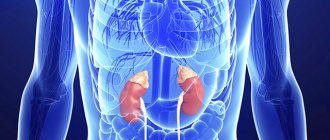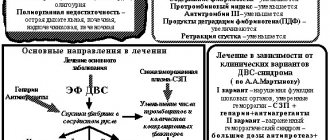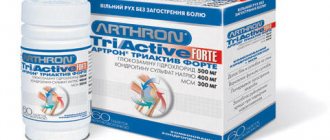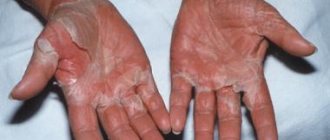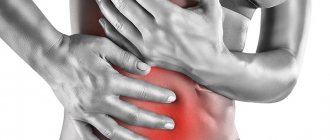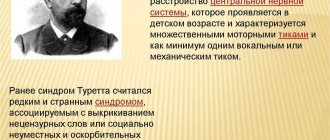General information
Tietze syndrome is an idiopathic chondropathy that affects the articulation of the 2nd, 3rd and 4th ribs with the sternum, most often on the left side, therefore it is also called costochondritis . It was described in 1921 by the German surgeon Alexander Tietze as an aseptic inflammation that damages and destroys the cartilage tissue of the costal joints.
Inflammation of cartilage tissue in Tietze syndrome
Complications and consequences
Complications of Tietze syndrome develop extremely rarely. But sometimes a syndrome of excessive calcification of cartilage tissue develops. This is accompanied by ossification of the costal cartilages, their deformation and loss of basic functions. In this case, the pain may intensify and become chronic.
In such cases, the breathing process may be disrupted and respiratory failure may develop due to chest rigidity. Another possible consequence is chest deformation.
Pathogenesis
A nonspecific chronic inflammatory process can last 3-5 weeks; swelling in the area of the lesion persists for several months and may resemble a pseudotumor.
The pathology causes cartilage calcification and osteoporosis in the adjacent areas of the ribs and sternum. As a result, thickening occurs - hyperplasia of the costal cartilages and periosteal layers on the anterior bone ends of the ribs, possible narrowing of the intercostal spaces and deformation of the costosternal joints, damage to the intercostal nerves.
Classification
Depending on the distribution of chondritis, it happens:
- damage most often to only one costal cartilage is usually II and accounts for up to 60% of all known cases;
- several costal cartilages are involved in the pathological process, for example II and III, and occurs in 15-30% of patients;
- in rare cases - 1.5-10%, inflammation affects the entire sternoclavicular joint.
Relapsing polychondritis
Costochondritis may be part of relapsing polychondritis , an episodic inflammatory and destructive disease affecting the chondrocostal joints and knee joints. Less commonly, the disease may cause the development of conjunctivitis, scleritis, keratitis, iritis, choreoretinitis , destruction of the cartilage of the larynx, trachea, bronchi, and inner ear. It can affect the excretory and integumentary systems, but it is most dangerous when it affects the cardiovascular system, causing aortic regurgitation, pericarditis, myocarditis, aortic aneurysm or aortitis .
Polychondritis has a remitting nature, which manifests itself in the form of attacks of acute inflammation that disappear after a few weeks or months, and then return as repeated attacks several years later.
How the disease develops
In most cases, Tietze syndrome is unilateral and is more common on the left side of the chest. In 60% of cases, the cartilaginous zone of the 2nd rib is inflamed, in 30% of cases the cartilage of the 2-4 ribs is inflamed, and in 10% the costal cartilage of the 1st, 5th, 6th ribs is affected.
The disease has a long course with periods of exacerbations and remissions. A few months after the onset of inflammation, degenerative-dystrophic changes begin in the cartilage tissue. Cartilage loses its shape, decreases in size, and becomes intractable. Some of them are impregnated with calcium salts and are susceptible to the process of sclerosis. The damaged area develops bone density, which contributes to the development of visible deformation of the chest, reducing its motor efficiency and elasticity.
Pectus excavatum may be a consequence of Tietze syndrome
Causes
Tietze's disease can begin to develop without an established cause; young people aged 20-40 years are at risk. However, cases of the disease have also occurred at an earlier age - in adolescents 12-14 years old, when the most intense growth processes of the musculoskeletal system are observed.
Swelling on the sternum with Tietze syndrome
So far, it has not been possible to find the reasons that trigger inflammation of the cartilage tissue in the sternum area, but presumably this can be facilitated by:
- injuries, especially chronic ones in athletes;
- heavy physical activity;
- respiratory diseases;
- coughing ; _
- reduced immunity and deficiency of vitamins B and C ; calcium metabolism disorders, including a history of rickets
- previous operations on the sternum.
Provoking factors
The exact cause of Tietze syndrome is unknown. There are several theories in medicine, but none have reliable confirmation or refutation.
The disease accompanied by costosternal syndrome is of non-infectious origin. Many doctors associate the occurrence of pathology with microscopic injuries that occur under increased loads.
According to the traumatic theory, with increased loads on the sternum in the area of connection with the ribs, damage occurs. As a result, irritation of surrounding tissues leads to inflammation. Intense pain is due to pressure on the nerve endings.
Another common theory is dystrophic. She explains the development of the syndrome by metabolic disorders, as a result of which calcium metabolism is disrupted.
Based on theories, the factors that provoke Tietze syndrome are:
- increased physical activity;
- previous injuries;
- surgical intervention;
- diseases accompanied by intense cough;
- chronic intoxication of the body;
- lack of vitamins and microelements due to arthritis or arthrosis;
- allergy.
In addition, the development of costochondritis is associated with a decrease in the body's defenses caused by autoimmune diseases.
Symptoms of Tietze syndrome
The main manifestation of the syndrome is a spindle-shaped dense swelling of 3-4 cm and local pain in the heart area ( cardialgia ). Painful symptoms can occur quite suddenly and spread - radiating along the rib line, radiating to the neck, shoulder, upper abdomen.
Symptoms of Tietze syndrome intensify during forced, deep acts of breathing, with a sharp movement of the arms to the sides, with palpation and pressure, and also sometimes with physical exertion.
Tests and diagnostics
Symptoms of Tietze syndrome may resemble cardiopathy and angina , but are not relieved by nitroglycerin , therefore, in addition to collecting anamnesis data and examination, it is necessary to take an x-ray, which can reveal irregularly shaped spots in the area of the II-IV ribs. To exclude cardiac and infectious origin, an ECG and puncture biopsy can be performed.
In addition, you may need:
- blood test data;
- ultrasound examinations;
- images obtained from multi-slice computed tomography.
Diagnostic measures
Tietze syndrome is diagnosed and treated by surgeons, traumatologists, orthopedists, and general practitioners.
Diagnosis of pathology is based on analysis of the clinical picture. Chest pain and dense swelling, not detected in other diseases, can suggest pathology. Swelling at the junction of the ribs with the sternum is detected during a visual examination. Palpation reveals pronounced localized pain.
There are no specific changes in the general analysis of blood and urine, as well as in the biochemical composition of the blood. In rare cases, signs of nonspecific inflammation may be detected in the blood.
Instrumental diagnostics:
- X-ray examination does not reveal early signs of the syndrome, but allows one to exclude the presence of other diseases. In the process of further development of pathology, structural changes in the cartilage are detected, its thickening and calcification, narrowing of the spaces between the ribs.
- is capable of recognizing the characteristic changes of Tietze syndrome in the early stages .
- MRI reveals all processes occurring in the rib tissue.
- A puncture biopsy determines degenerative changes in cartilage. This painful procedure is performed only if there are appropriate indications.
Treatment with folk remedies
The healing properties of natural ingredients help relieve inflammation, improve blood circulation at the site of the disease and increase the body's immune strength. Traditional healers know that the following help cure chondritis:
- baths and compresses based on herbal mixtures of thyme, sage, juniper fruits, St. John's wort, rosemary;
- steamed lemon balm and horseradish leaves;
- rubbing swelling on the chest with pork or bear fat;
- rubbing birch buds or eucalyptus with alcohol tinctures.
Regardless of the chosen traditional treatment method - compress, fat, rubbing, lotions, the sternum should be wrapped in a warm scarf or other cloth and the patient should be provided with peace.
How to treat this disease?
It should be noted that this disease can only be fully treated surgically - using subperiosteal resection. But this situation is considered an extreme case and usually doctors try to get by with medication methods of treatment.
How to treat Tietze syndrome without the help of a surgeon? Conservative therapy involves the use of non-steroidal anti-inflammatory drugs (both in the form of tablets and as part of ointments and gels), which are the main focus in the treatment process. Naturally, such medications cannot eliminate fibrocystic formation, but they successfully reduce inflammation and swelling, and also reduce pain. If necessary, analgesics can also be prescribed. For severe pain, novocaine blockades with corticosteroids are used, which also helps get rid of pain.
Since Tietze syndrome is a chronic disease that constantly “returns”, and non-steroidal anti-inflammatory drugs tend to cause a number of unpleasant side effects, doctors often encourage treatment with traditional methods. Traditional medicine, of course, is not able to relieve pain so quickly and effectively, since most of its methods are based on the simple effect of heating. But such methods can reduce swelling and reduce inflammation, due to which the pain also subsides.
Before using any “folk” method or remedy, you should consult a doctor - only a specialist will be able to objectively assess whether each specific recipe will be harmful. But the most common methods are relatively safe alcohol-based ointments and rubs, which have a warming effect.
Prevention
To prevent Tietze disease it is recommended:
- visiting balneological resorts - using the healing properties of mineral waters, mud, swimming in public baths, inhalation;
- since the etiology of the diseases has not been established, it is best to give preference to a healthy hypoallergenic diet rich in chondroprotectors ;
- normalize physical activity, especially on the chest and upper shoulder girdle;
- undergo regular examination by your family doctor.
Diet for Tietze syndrome
Hypoallergenic diet
- Efficacy: therapeutic effect after 21-40 days
- Timing: constantly
- Cost of products: 1300-1400 rubles. in Week
It is based on the principles of healthy and hypoallergenic nutrition, which help maintain normal weight and provide the body with everything it needs. It is also advisable to include in the diet:
- dietary jellied meats and jellied meats – rich in gelling substances;
- sweet bell pepper – improves microcirculation and is rich in vitamin C and antioxidants ;
- a sufficient amount of dietary protein that is easily digestible, ensuring the course of intense plastic processes;
- greens - spinach and parsley, which contain a lot of vitamin K and promote tissue renewal;
- olive oil – has anti-inflammatory and antioxidant effects;
- cherries, berries, pomegranates - eliminate symptoms and prevent the development of degenerative diseases of the musculoskeletal system;
- low-fat dairy products – saturate the body with calcium and healthy fats.
At the same time, it is important to limit the consumption of table salt as much as possible, since it retains fluid and prevents the reduction of inflammation.

